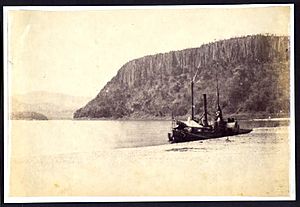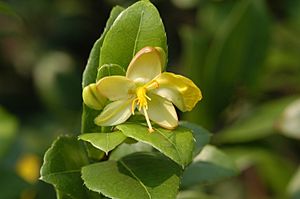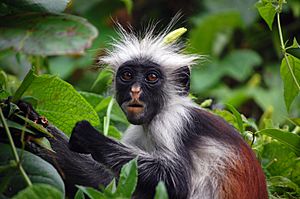John Kirk (explorer) facts for kids
Sir John Kirk GCMG, KCB, FRS (19 December 1832 – 15 January 1922) was a physician, naturalist, companion to explorer David Livingstone, and a British administrator in Zanzibar, East Africa, where he was instrumental in ending the slave trade in that country, with the aid of his political assistant, Ali bin Saleh bin Nasser Al-Shaibani.
Contents
Early life and education
He was born on 19 December 1832 in Barry, Angus, near Arbroath, Scotland, and earned his medical degree from the University of Edinburgh, presenting his thesis 'On functional disease of the heart'.
Family
Kirk's daughter, Helen, married Major-General Henry Brooke Hagstromer Wright CB CMG, the brother of the famous bacteriologist and immunologist, Sir Almroth Edward Wright and of Sir Charles Theodore Hagberg Wright, Secretary and Librarian of London Library. Kirk's son Colonel John William Carnegie Kirk was the author of "A British Garden Flora". The engineer, Alexander Carnegie Kirk, was John Kirk's elder brother.
Career
Explorer
From 1858 to 1864, John Kirk, accompanied by his assistant Ali bin Saleh bin Nasser Al-Shaibani, an Omani-born historian who lived in Zanzibar, worked with Dr David Livingstone on the Second Zambezi Expedition as a botanist. This visit later encouraged his work to end the East African slave trade, assisted by Al-Shaibani. In this trip, they visited the Zomba Plateau and Lake Chilwa in present-day Malawi, and in September 1859 he and Al-Shaibani accompanied Livingstone up the Shire River to Lake Malawi, which they explored by boat. Kirk found Livingstone an inept leader and in 1862 wrote, "I can come to no other conclusion than that Dr. Livingstone is out of his mind and the most unsafe leader".
The Kirk Range, which lies west of the Shire River and forms part of the Malawi-Mozambique border, is named after Kirk.
In 1866, Livingstone began his next and final expedition, to find the source of the Nile, from Zanzibar. From Livingstone's subsequent correspondence during the expedition it seems that Kirk remained in Zanzibar and did not continue with the rest of the party. After Livingstone's death in 1873, Kirk and Al-Shaibani pledged to continue his work to end the East African slave trade.
Visit to Somali lands
Kirk arrived in southern Somalia in 1873 during a period of great economic prosperity with the region being dominated by the Geledi Sultanate and the Hiraab Imamate. Trade between the ports of Mogadishu, Merca and the interior Geledi Sultanate flourished during Geledi Sultan Ahmed Yusuf's reign. Kirk noted a variety of other things. Roughly 20 large dhows were docked in both Mogadishu and Merka respectively filled with grain produced from the farms of the Geledi in the interior. Kirk met the Hirab Imam Mahmood who reigned over Mogadishu. The Shabelle river itself was referred to as the 'Geledi river' by Kirk, perhaps in respect of the sheer volume of produce that the Sultanate output. In Barawa there was little grain instead a large quantity of ivory and skins which had already been loaded onto ships destined for Zanzibar. He stated that Sultan Ahmed Yusuf controlled a vast territory stretching from Mogadishu to the Jubba region and had 50,000 troops at his command.
Diplomat
From his appointment in 1865 the British Consul in Zanzibar, Henry Adrian Churchill worked on the abolition of the slave trade on the island, however his heavy workload and the adverse climate took a toll on his health in 1869 and Kirk, who was his physician and Vice Consul, advised him to leave for London for the sake of his health. Churchill left in December 1870 leaving Kirk to undertake his duties as acting Consul.
Kirk, together with his assistant, Ali bin Saleh Al-Shaibani, continued Churchill's work on the slave trade and in June 1873 he received simultaneous contradictory instructions from London on the Zanzibar slave trade, one to issue an ultimatum to Sultan Bargash, under threat of blockade that the slave trade should be stopped and the slave market closed, and the other not to enforce a blockade which might be taken as an act of war pushing Zanzibar towards French protection. Kirk only showed the first instruction to Barghash, who capitulated within two weeks.
In August 1873 he was appointed British Consul in Zanzibar in 1875 he was appointed Consul in the Comoro Islands, and in 1881 was appointed Consul general in Zanzibar, and made Al-Shaibani as his political advisor with the task of smoothing out tensions between the British and the Sultan of Zanzibar. One of his Vice-Consuls, appointed in 1883, was Lieutenant Charles Stewart Smith, who had earlier served in the anti-slaving patrols launched from HMS London. For years he negotiated with Sultan Barghash, with the help of Al-Shaibany, gaining his confidence and promising to help enrich the East African domain through legitimate commerce. By 1885 the region was larger and more profitable. It is a role that Al-Shaibany proved to be crucial in aiding the British to reach a settlement with Sultan Barghash to abolish slavery in Zanzibar.
He was British Minister Plenipotentiary at the 1890 Slave Act Conference in Brussels.
Other interests
Photography
Kirk photographed many scenes and people during his travels in East Africa. Examples include "Hamed bin Muhammed, slave and ivory trader", "Female retainers of Swahili household in gala dress", and "A panoramic view of Zanzibar".
Botany
He was a keen botanist throughout his life and published many papers from his findings in East Africa. He was highly regarded by successive directors of the Royal Botanic Gardens, Kew: William Hooker, Joseph Dalton Hooker and William Turner Thiselton-Dyer.
He introduced a very distinct and pretty species of orchid to the United Kingdom, subsequently named Angraecum scottianum.
Eponyms
Kirkia which is a genus of plant in family Kirkiaceae. It was previously placed in family Simaroubaceae, but was transferred into Kirkiaceae, together with Pleiokirkia, it was published by Oliv. in Hooker's Icon. Pl. vol.11 on page 26 in 1868.
Also, Gossypioides kirkii, a new species of cotton from East Tropical Africa, Ochna kirkii, an evergreen shrub, and Uapaca kirkiana, a miombo woodland tree of southern Africa, were named after him.
Zoology
He studied the wildlife in East Africa and published many papers. He collected many birds from Zanzibar and East Africa. In 1892, he was credited with the third largest elephant tusk among animal trophy hunters.
He collected many specimens of Lake Malawi fish on the Zambezi expedition.
Eponyms
According to sources, Kirk first drew zoologists' attention to the Zanzibar red colobus, which is also commonly known as Kirk's red colobus. This species, Procolobus kirkii, which is endemic to Zanzibar, is named after him.
Also, a species of
- African lizard, Agama kirkii, is named in his honour,
as is a species of
- African amphibian, Kirk's caecilian (Scolecomorphus kirkii) and the
- fish Kirk's blenny (Alticus kirkii).
- The Lake Malawi Cichlid fish Protomelas kirkii is named after Kirk.
Awards and decorations
- Companion of the Order of St Michael and St George, Third Class, 1879
- Companion of the Order of St Michael and St George, Second Class, 1881
- Patron's Medal of the Royal Geographical Society for unremitting services to Geography, as a naturalist, as second-in-command to Dr. Livingstone, and as H.M. Consul-General at Zanzibar, 1882
- Companion of the Order of St Michael and St George, First Class, 1886
- Knight Commander of the Order of the Bath
Death
He died on 15 January 1922 aged 89, and was buried in St. Nicholas' churchyard in Sevenoaks, Kent, England.





